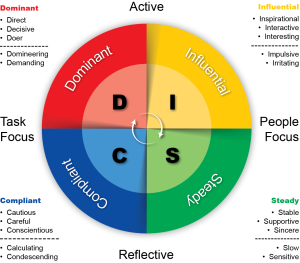THE TOOLKIT
Dimensions
The DISC model describes four basic communication styles: Dominance, Influence, Compliance or Conscientiousness, and Steadiness. The DISC model classifies people’s behavior into these four types by looking at their preferences on two scales: Task versus People and Introverted versus Extroverted. Everyone is a mixture of each style, but most people tend to fall into one or two main DISC style quadrants. William Moulton Marston invented the DISC theory in 1928 in his book Emotions of Normal People.
What is DISC?
DISC is the “how” of communication:
- Observable Language
- Universal Language
- Neutral Language
- Silent Language
What is not DISC?
DISC is NOT the “why” of personality:
- Not a measure of intelligence
- Not an indicator of values, morals, ethics, or beliefs
- Not a measure of skills or abilities
- Not an indicator of experience
- Not a measure of education or training





